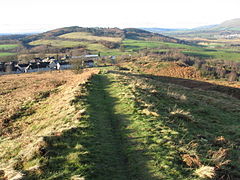Croy, North Lanarkshire
Croy
|
|
|---|---|
 View from Croy Hill looking towards Culmuir View, with the Bar Hill area in the distance. |
|
| Croy shown within North Lanarkshire | |
| Population | 650 (2001 census) |
| OS grid reference | NS624553 |
| Council area | |
| Lieutenancy area | |
| Country | Scotland |
| Sovereign state | United Kingdom |
| Post town | GLASGOW |
| Postcode district | G65 9 |
| Dialling code | 01236 |
| Police | Scottish |
| Fire | Scottish |
| Ambulance | Scottish |
| EU Parliament | Scotland |
| UK Parliament | |
| Scottish Parliament | |
Croy is a village in North Lanarkshire, Scotland. A former mining community, Croy is situated some 13 miles (21 km) from Glasgow and 37 miles (60 km) from Edinburgh on the main railway line between the two cities.Croy railway station is the transport hub for the surrounding area and is one of the busiest stations in the Scottish Central Belt. The station has frequent services 7 days a week to Glasgow, Edinburgh & Stirling. The station has undergone significant expansion in recent years including extended platforms, increased car parking facilities and a new station building & ticket office. Further improvements and maintenance are expected until at least 2017.
On Croy Hill, to the north east of the village, are remnants of the Antonine Wall, built by the Romans between AD 142 and 144, including a fort and two beacon platforms.The fort is not visible on the ground today, but the Antonine Wall ditch is easily identifiable across much of Croy Hill. Croy Hill’s high position offers one of the best views of the surrounding landscape, including the Firth of Forth and hills of Fife to the east, the Kilsyth Hills to the north, and the next fort at Bar Hill to the west. A tombstone was found at Croy Hill, showing a soldier flanked by men, possibly his sons. Other finds include a bronze arm purse, now in the Hunterian Museum. Croy was a key point in the Roman built Antonine Wall.
The modern settlement of Croy as it appears today was primarily the result of a coal mine being established in the mid 1800s. This attracted a sizable population of Irish immigrants to the area seeking employment and is the reason for the villages strong Roman Catholic origins. A single row of original miners cottages are still present and in use on the Constarry Road high street. They feature a highly distinctive red brickwork and are exceptionally well preserved. The local residents affectionately refer to the row as Coronation Street - due to the similarity with the houses of the iconic UK television series.
...
Wikipedia

